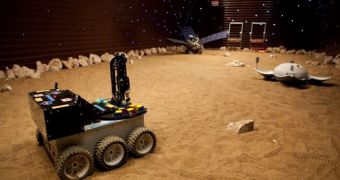Six “astronauts” in a simulation chamber in Russia reached an important milestone in their mission to visit the Red Planet. After more than 244 days of interplanetary travel, they finally reached the surface of their target, where they will remain for a few days.
The Mars500 experiment is the first full-duration simulation of a prospective mission to the Red Planet. It models the exact conditions that a crew traveling away from Earth on a space exploration mission would encounter.
While the goal of the research effort it not scientific in nature, it is designed to tell whether one and a half years of isolation is cause for concern for an astronauts crew. When the actual flight will be conducted, a similar, six-astronaut crew will most likely be the prepared alternative.
In the simulator, three “astronauts” are preparing to set foot on the Red Planet. Their sortie will take place on February 12, and will be followed by two other extravehicular activities in the coming days.
Located at the Institute of Biomedical Problems (IBMP) in Moscow, the spacecraft simulator also includes a chamber that replicates the surface of the planet. Astronauts who will land there will conduct experiments, test equipment and deal with any possible glitches.
Like the rest of the modules, all chambers are hermetically sealed. Conditions inside replicate the Martian environment. Communication devices even have built-in delays, that simulate the 10 minutes it takes for radio signals to get from Earth to Mars.
“Mars500 is a visionary experiment. Europe is getting ready to make a step further in space exploration: our technology and our science grow stronger every day. Mars 500 today is only an enriching simulation, but we are working to make it real,” explains Simonetta Di Pippo.
The official is the ESA Director for Human Spaceflight. The European Space Agency is conducting the investigation in collaboration with the Chinese National Space Administration (CNSA) and the Russian Federal Space Agency (RosCosmos).
After they finish exploring the surface of the planet, the astronauts will fire off their virtual engines at the beginning of March, and will start their long journey back home. They are scheduled to “return” to Earth sometime in November 2011.
This simulation is providing scientists with ways of figuring out what type of group dynamics form under such conditions, and to determine which factors threat the overall goal of the mission.

 14 DAY TRIAL //
14 DAY TRIAL //